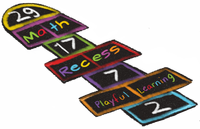About The Book
Mathematics is wonder-filled, awe-inspiring, joy inducing playground of the mind is the claim of this book. In stark contrast to most peoples experience with this subject Singh and Brownell paint a picture of a system of playing with ideas, relationships, numbers, and shapes that has fascinated humanity for literally 1000’s of years. This book is meant to inspire that sense of wonder and simultaneously challenge the means by which mathematics is communicated in schools today. No you will not find page after page of exercises inside. There are no, “If train A leaves Station A going 40 mph…” mind-numbing and stupid problems inside here https://openresume.io/which-of-the-following-is-a-do-regarding-scannable-resumes/ .
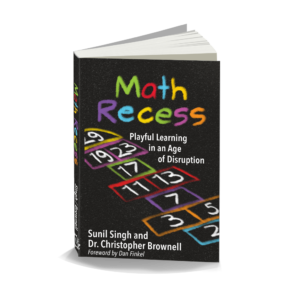
Within this book are examples of puzzles and paradoxes, challenges and conundrums, along with a few stories of discovery, coming of age, and the overall human story that is this jewel of the intellect, “mathematics.”
We hope you read the book with a laptop, a pencil and paper, a calculator, a beverage of your choosing and better yet a good friend to talk about the ideas within it. Mathematics has been created by societies, individuals working within their cultures to solve problems and for the sheer joy of knowing something. This is what we hope you see inside our little romp and tumble down the rabbit’s hole. Please feel free to send us questions about ideas within, we may not have any answers but sure do love to think along with you. There are ways to contact us on the Contact Us page.
Finally, throughout the book you will see references to websites, videos, games and blog posts. They have all been collected and are viewable, by chapter, on the Support page of this website.
Introduction
All too often the rabbit hole is as far as you have dug.
—Gary Hopkins
The date was October 6, 2017—one of the most auspicious days in the evolution of the book you are holding. The morning was a joyful, carefree, and happy romp through a bouillabaisse of math puzzles, problems, and perplexities in the Bronx. The afternoon had me (Sunil) shuttle off to a tiny cafe in Brooklyn to meet the most important person in shaping my views on math education over the past twenty years. How important? Imagine being a beer league hockey player or scratch golfer and getting invited to lunch by Bobby Orr or Annika Sorenstam in their hometown. This person was that important.
After arriving at Tazza cafe several minutes before our 1:30 meeting, I pulled out a hardcover copy of my first book, Pi of Life: The Hidden Happiness of Mathematics, glanced over the signed page, and slid it to the opposite side of the small table I had secured.
Then I sat back and waited. Before long, 1:30 came and went. As did 1:31, 1:32, and 1:33. That’s how nervous I was. By 1:40, my gut feeling was that something had gone wrong. Gone wrong on my side. My lunch companion had emailed me that he would have to leave by 2:30 at the latest. I walked to the counter and asked the question that I dreaded hearing the answer to: “Is there another Tazza cafe?” The person, sensing my deflating tone, replied with an almost embarrassed, “Yes.” Another location was just a fifteen-minute walk up the street. I didn’t think I had one more minute, let alone fifteen, but I quickly shuffled out of Tazza One to head to Tazza Two. Faster than a speed-walk but slower than a mangled sprint, I huffed and puffed my way into the correct meeting place. The time was 1:58. I was a perfect twenty-eight minutes late (I would have preferred six!). But he was there. Wearing the green shirt and black shorts he described in his email, Paul Lockhart sat unassumingly in the corner, flipping through a signed copy of his third book, Arithmetic.
Eight years after we started communicating—just before he published his landmark first book, A Mathematician’s Lament: How School Cheats Us out of Our Most Fascinating and Imaginative Art Form—we were finally about to meet. Our initial conversations swirled around many of the elements that are contained in this book. And, like good wine I suppose, they are uncorked a decade later!
Never in my wildest dreams had I ever expected that we might one day exchange signed books. The previous anxiety-riddled moments evaporated with our earnest embrace, and the hour that followed was like being at The Oracle of Delphi with Willy Wonka—deep wisdom soaked with charming quirkiness. In that all-too-brief meeting, I was lucky to snatch a gold nugget from Lockhart. As we said our goodbyes, he nonchalantly remarked, “My job is to provide math recess.”
Mic drop.
In the seconds after Lockhart shared those two seemingly disjointed words, I knew that I had to write a second book and that the title had to be Math Recess. At that same moment, I decided the purpose of the book, at its heart, would be to transform the oil-and-water relationship between math and recess into something more like bread and butter. (Sorry, but as delicious as it sounds, I have never had peaches and cream.)
One of the key ideas about recess is socialization and nurturing friendships. It only made complete sense to deeply write about mathematical play with my good friend Chris Brownell. We make a good team because we agree that our mission isn’t to build a bridge between recess and math. That bridge already exists. Construction started, oh, a few thousand years ago. Our mission is to create a more delectable way of discovering mathematics—one that is bold and boisterous! Taking the same care that we use when folding in egg whites, we want to fold math into our students’ social and experiential learning.
A Siren’s Call
I (Chris) think most people would agree that recess is the epitome of childhood freedom and delight, while doing math is on par with detention or being sent to the principal’s office. Sunil and I want to change that mindset, and our passion for discovering new ways to teach math has led us to a life-changing friendship and collaboration. We are an unusual team. He’s from Canada, and I’m from the United States. He eats volcanic-level spicy food, and I am on the much milder side. He listens to some pretty heavy music, while my ears lean toward the jazzier side of things (my recent evening with KISS aside), his sport preference is hockey (a dizzying whirlwind to me), mine baseball (a thinker’s game 😉 ). However, the wonders of modern technology provided us an opportunity to chat in a Facebook group, exchange several similarly impassioned and oriented posts, and eventually discover that we were going to attend the same National Council of Teachers of Mathematics conference in April 2016 in San Francisco. We decided to meet before the conference and share a beer—a simple social act that will play a significant role in this book.
I mention this because it reminds me of the way I met and made friends in school. I moved to what is now my hometown, Fresno, California, in late summer of 1969, a kid not quite ready for fourth grade. I didn’t know anyone, but in the first week or so, I had several encounters with guys, some of whom I remain in contact with and consider friends. Most of that friendship building, however, happened during recess. During that free play, we’d make up games, challenge each other’s abilities, laugh, run, stumble about, skin knees and elbows, give and receive bruises, and generally just enjoy being alive. That same freedom, humor, and adventure has been characteristic of my friendship—and our first official collaboration—with Sunil. So many good things in my youth—and some of the best from my 50s—have grown out of the unstructured play of recess.
It might seem odd that we have chosen mathematics and specifically mathematics teaching as our focus for this book. This is a subject that is most often seen as being about structure, rigid adherence to rules, and a no-nonsense attitude toward reality that is mathematics in the hands of a former ski-bum and a court jester. In his wonderful book, How Mathematicians Think: Using Ambiguity, Contradiction, and Paradox to Create Mathematics, William Byers describes this phenomenon of seemingly antipodal juxtaposition as being what it takes to be creative in mathematics (and perhaps any field).
Sir Ken Robinson, a frequent speaker at conferences whose TED Talk video holds the record for most views, speaks at great length about how modern schooling is stifling creativity and society will be the worse for it. With this book, Sunil and I seek to proceed orthogonally from the present perception of mathematics and mathematics education. We plan to push in a direction that reveals mathematics as a creative, vibrant study with twists and turns like any good mystery novel. That is what we hope this book is for all who read it.
This is a book to take to the beach, to the pub, or to anywhere you hang with friends who enjoy an intellectual challenge. Interspersed throughout you will find conversations, some even real. Make no mistake, however: we are sounding a call, a siren’s call if you will. We hope to lure you to our perspective, and yes, you should expect this call to ask you to embrace a disrupted future. A future in which mathematics education will no longer be characterized by mind-numbing hours of meaninglessly repetitive drudgery and proven ideas, but one in which mathematics is viewed rightly as a messy, noisy, playful human undertaking. We will also go further and lace that call with joy, mathematical for sure, but joy and hope for a brighter, if more openly constructed, future.
Subversive and Adventurous
I (Sunil) think we can reach that brighter future by remembering our past. Think back to your earliest school days and recall the sound of recess. That sound is universal. Doesn’t matter where you are in the world. That sound of children’s chatter, yelling, and screaming might seem harsh on the ears, but search “sounds of recess” on YouTube and you will get more than one hundred thousand results. Some of these videos are even titled “ambient background,” clearly characterizing these sounds as happy and soothing. And why not? They are the sounds that inspire poetry. They are the sounds that inspire disruption.
It was during recess—a time with no agenda or order—that you and your friends could have all kinds of silly and daring conversations. Chris and I have certainly done that a time or two. Some of our most spirited conversations have been over beer while leisurely unpacking the magic of mathematics like laughing children.
What lies ahead of you in this book are fifty thousand words to rebuild, reconstruct, and reimagine the spirit of learning mathematics—and marry it, once and for all, to the natural curiosity and wonder of being a child. This marriage will not be a conventional union. Creative disruption doesn’t settle for a traditional church wedding and lovely roast beef reception. It elopes to Las Vegas, gets married by an Elvis impersonator, and celebrates by playing $1 blackjack with locals on Fremont Street.
At its core, mathematics has always had a subversive and adventurous streak, but traditional educational institutions have shackled anything that lies outside the narrow domain of schoolhouse math. There simply hasn’t been a whole lot of innovation since ‘rithmetic came on the scene, and too many educational leaders have, unfortunately, deemed the subject closed, dead, and completely unearthed and exhausted. Don’t take my word for it. Ask the millions of students who have learned to loathe mathematics thanks to boredom, confusion, and irrelevance during the past one hundred years.
Throw worksheets, homework, tests, and grades upon this miserable heap, and you get the tire fire that was twentieth-century math education. A chaotic snooze fest that riddled many kids—and their teachers—with anxiety. We speak in the past tense because, thanks to a new generation of math educators, we are steadily moving away from the narrow and linear narrative of drill and kill.
The progress is slow, not nearly the disruptive velocity needed to escape the anachronisms of the past. And having sympathetic parents hovering over their children doing math at home only adds to the negativity. According to a 2015 New York Times article, “Square Root of Kids’ Math Anxiety: Their Parents’ Help,” a study published in Psychological Science found that first- and second-graders whose parents had math anxiety were learning less math and were more likely to develop their own math anxiety when their parents provided frequent help on their math homework. Researchers tested 438 students from twenty-nine public and private schools across three midwestern states, finding a strong correlation between overly anxious parents and negative student performance. So much for good intentions.
The sad reality? Children are smothered. Children are coddled. Children are just bloody exhausted. And guess what? It is not just kids who suffocate and struggle in this environment; so does the subject they are presumably learning. Mathematics needs to breathe as well. The gulf between what students see and what they should see might as well be measured in light years.
Mathematics and children need time and space. Time for wondering and space for wandering. Mathematics education needs to start again with a new premise and a new promise: Mathematics is a joyful adventure of shared stories and experience. Dancing on the embers of poorly photocopied worksheets and buzzkill tests will be the first order of business.
As referenced earlier, mathematics learning should not only sound like recess—everything from bubbly laughter to meditative silence—it should look like it too. Classrooms should and can look like math playgrounds. Shape blocks, Unifix cubes, puzzle books, math games, walls teeming with number lines and patterns created by students, some technological devices, riddles, conundrums, unsolved problems, open problems, symmetrical art, game theory, and so much more. All interwoven with the communal bliss of learning together.
The mathematical learning experience should recreate the awe and mouth-agape look on Charlie Bucket’s face when he first saw the chocolate factory (just to be clear, we are talking about the spectacular 1971 Gene Wilder film, Willy Wonka & the Chocolate Factory, and not the creepy, futuristic reboot).
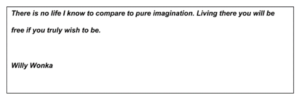
Happy Exploration
Traditional models of schools are prisons with very wide bars. Freedom is an illusion for both students and teachers. At some point, there is accountability to the unchecked authority of the past pedagogical practices. Standardized curriculum, outcomes, and expectations raise the bar for benign, factory efficiency—and lower it for everything else.
Our schools have, sadly, moved well beyond what Lockhart revealed to us in A Mathematician’s Lament. The cheating that’s happening not only enables a path to well-documented apathy, it deprives students of experiences that are empowering and emboldening—such as seeing the world through a lens of symmetry, beauty, and delight.
Mathematics is a bloody art form. At its heart, math is the messy fun of finger-painting. In 2017, Mitchel Resnick, Director of the Lifelong Kindergarten group at the Massachusetts Institute of Technology Media Lab, released the timely book entitled Lifelong Kindergarten! In it Resnick espouses what he calls the “Four P’s of Creative Learning,” Projects, Peers, Passion, and Play. We see mathematics as a study in which these all can be brought into everyone’s experience. Although many passages from the book reverberate with the messages of this book, the following passage encapsulates the spirit of playfulness and the personal value of such exploration:
“Today, everyone needs to be a risk-taker, a doer, a maker of things—and not necessarily to bend the arc of history, but to bend the arc of their own lives.”
Children need to leave their thumbprints all over their journey of mathematics. Only then will there be a possibility of nurturing that most treasured goal—a lifetime interest in learning mathematics. Here too we both see a call for human flourishing, a call we are not alone in making either.
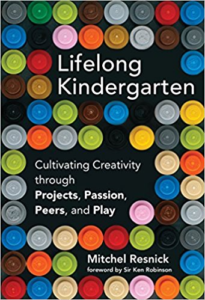
Math Recess aims to be the first math book that surfs the magnificent waves of joy that result from adopting a kindergarten mindset for K-12 math learning. Our plan is to deliver ideas, goals, hopes, and dreams of mathematics becoming one of the most loved subjects in school.
There is a long way to go. We are well past subtle and polite changes and far beyond merging ideas with the speed of erosion. We are just plain fed up with mathematics teaching that first appeases the desires and mandates of adults but is carefully disguised as a societal requirement for children. Do you think the fast introduction of worksheets, constant testing, ahnd grades sounds like a construct for lifelong kindergarten? Quite the opposite. And, in the exact opposite direction we must run—for the sake of our children.
We are in the age of glorious disruption! Everything is up for debate. Everything is up for discussion. Everything needs to be rethought. Now. In mathematics education, that disruption will result in a classroom that is some wacky hybrid of entrepreneurial innovation centers and free-range Montessori-like exploration.
When I (Sunil) was in Austin, Texas, for a tech conference in 2018, I stayed at a hotel next to Capital Factory, a giant incubator and meetup for Texas entrepreneurs. There were glass walls everywhere. Every morning at breakfast, I would stare up at all those rooms filled with young, energetic people dreaming of changing the world.
Many K-12 educators hope for the same, but their creativity, communication, and connections are hindered by the limits of traditional school designs and philosophies.
There are, however, many signs of innovation. They occur on a daily basis when teachers like yourselves exhibit the patience and imagination necessary to guide the learning of mathematics with greater flexibility. These small actions, collectively, are helping create a larger movement away from the rigid ideas of the past.
Creating revolutionary ideas and championing disruptive children—who will imaginatively improve on these ideas—begins with reconstructing learning experiences that model how children want and need to learn in the future. It needs to be social, experiential, visual, auditory, and tactile. In other words, it needs to have an environment that is as joyful and playful as recess. It seems natural that having that kind of time and space in solving mathematics problems would aid in creating not only a deeper but also a much happier exploration. Happier exploration is not a light goal. It means discarding anxiety and nervousness when learning mathematics. This applies to both students and teachers—and not just elementary teachers but teachers at all levels.
The Struggle Is Real—and That’s OK!
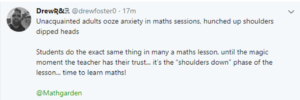
Drew Foster is an edtech specialist in England. He works with elementary and middle school students and teachers all the time. The shoulders-down posture is an important physical indication that a student is ready—truly ready—to learn mathematics. This is not a metaphor. It’s a literal, observable phenomenon in math class. Think about it. A person’s emotions are often visible to others, and teachers watch so many of them play out every day. Hunched shoulders indicate frustration, anxiety, even worry, and a relaxed shoulders-down posture—with arms swinging freely—indicates ease of mind and playfulness. Learning and exploring mathematics with marked anxiety is akin to digesting food under stress. It is an established fact that eating while anxious often hinders healthy digestion and presents a higher probability that food gets stored as toxins. Nothing beneficial happens during anxiety. This also applies to digesting mathematics.
Chris and I want all math classes to be filled with students assuming the shoulders-down posture. And you too! Whether you are an experienced middle school teacher, a first-year elementary teacher, or an administrator, we want every essence and idea of this book to be approached with shoulders down. This will especially be asked of you when you get to some of the latter chapters in the book, as they will bring new and challenging ideas for many of you. There are no shortcuts in learning mathematics. For anyone. Everyone struggles with mathematics at various points in their lives. Struggle is the only way.
In December 2018, Thomas J. Williams, president of the North Carolina–based Strategic Educational Alliances, and former superintendent of education in North Carolina, tweeted one of my Medium articles. He referenced this idea of struggle and suggested it could be the mindset for everyone—teachers and parents—in forging new and emerging spaces for redefining math education.
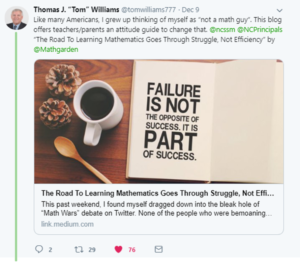
Struggle does not have to feel isolated and riddled with anxiety. It can be, however, with the aid of this book, and a friend or two, lots of playful fun!
For this to occur, the math must be compelling, and time must be given. Some of the greatest mathematical mysteries took centuries and generations of mathematicians to solve. We, as math educators, have to collectively honor those efforts. Struggle never goes away in mathematics. It is its lifeblood.
I (Chris) recently met a mathematical artist from Portugal online. He does a fair amount of work using what is known as spherical conformal mapping or spherical perspective. He and I are in the same Facebook group, and he had posted photos of a few of his drawings. The comment that caught my eye was “Know the rules, break the rules!” That’s the very essence of recess. It is in recess where we learn to make and break all kinds of rules.
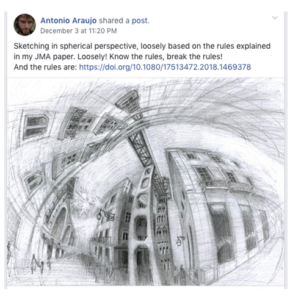
To quote my co-author’s Medium article, “If students are not actively engaged in mathematical struggle in safe and supportive environments, then they are not engaged in mathematical thinking. They are engaged in mathematical mimicking.” The absence of struggle will create the absence of mathematical thinking. Efficiency was a twentieth-century idea linked to industrialization. Struggle is a twenty-first-century idea linked to humanization.
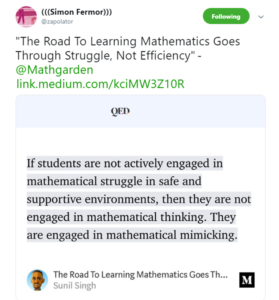
We must champion not only rule-breaking but the struggles it might represent or bring about in the classroom. But struggle can only be championed in a safe environment. Safe simply means happy. Wouldn’t it be nice if Bobby McFerrin’s “Don’t Worry Be Happy” could be part of a soundtrack to this kind of innovative learning? Of course, we would have to throw in the infectious samba rhythms of “Let the Children Play” by Santana!
My own memories of recess, from the 1970s, are kind of fuzzy, but I do remember that playing “foot hockey” with a tennis ball was a popular activity. When a tennis ball wasn’t available—or it was kicked inadvertently under a portable—we used a chunk of ice. Improvisational thinking. The same kind of thinking that creates multiple strategies in solving a math problem. We also had names for our games involving hockey cards—topsies, farthies, and knocksies. If you had the coveted red utility ball at recess, you played four-square, a game that included moves like the “tea party” (going head-to-head with another student) and the “around-the-world” (ensuring clockwise or counter-clockwise movement of the ball). There were also yo-yos, skip ropes, hopscotch, tag, British Bulldog, swings, monkey bars, tetherball, school gossip, and just random running.
Recess was time spent on a playground, but it was also a portal to understanding and navigating the freedom and friendship we found within our emerging world. It was a time to test yourself, fall, get up, laugh or cry, and get up and go again. The metaphor of recess will be both explicit and implicit in our book. It is meant to reinforce our belief that mathematics is fun. Our use of recess throughout this book is a reminder that we must create classrooms and school environments that offer more time to play in the sandbox of numbers. Recall too that recess was a time where confusion got ironed out, where some misunderstandings seemed to explode then come back into focus; these also are part of the doing of mathematics, and keeping learners from them is to short-change the process.
Before any large-scale changes can occur, the mindset of teachers must change. Teachers must desire that change. Desire creates stamina and courage to go the extra mile to ensure what is the most important thing here—the mathematical well-being of our children.
We believe that students and teachers should want to run toward mathematics, not away from it, as has happened so often in the past. Every math teacher, regardless of experience, knowledge, and circumstances, can support the revolution that is already afoot. We hope this book reignites your love of mathematics and catalyzes change within you at the deepest level possible—your heart! Only that love has the power to reshape the purpose for learning mathematics in this age of creative disruption.
We recognize that this book will be used within the contexts of your lives, your work, and most likely, your schools. As is often the case with books for teachers, we will include a few discussion questions at the end. We have intentionally not pigeon-holed activities by grade. Every class is different. The latitude for exploring many of these topics rests mainly on basic arithmetic.Feel free to break the rules of the game and ignore them, but you should know that we felt free to break the rules and include a smattering of unexpected and thought-provoking questions.
The bell is ringing. It’s time for math recess!
Here’s a
Sample
About the authors

Chris Brownell

Sunil Singh
Reviews
From
Amazon
“This book was so much fun to read! My students looked forward to finding out what I had read the night before. We had a great time exploring the various activities that the book provides. I found that my students wanted to play the games day after day and even came back the next day and said that had played the games with their family or alone at HOME! this was a bonus!”
“I appreciate the effort to share how math can be fun. I was a little disappointed that the pictures of Twitter were pixelated and low quality.I do like the amount of resources presented and the colloquial tone the author’s use to discuss their ideas. I think any math teacher would be happy with this purchase.”
“Not since the release of Lockhart’s A Mathematician’s Lament has anyone captured the collective pursuit of mathematics teachers across the globe! Singh and Brownell effectively demonstrate how to bring life back into classrooms through play and exploration of the most beautiful subject despite the current state of mathematics education. Out with the worksheets and in with socialization through mathematical play!”
About Book
Unable to load Tweets
Follow